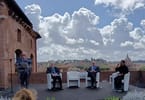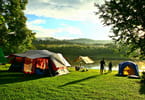Mention underwater archeological treasures and most people will think of shipwrecks full of chests of gold from far corners of the earth.
However, the United Nations Educational Scientific and Cultural Organization (UNESCO), together with the Egyptian government, is now planning to show the world that underwater archeology can be much more, by building the world’s first underwater museum to show the rich cultural and historical heritage that can be found under the Bay of Alexandria in northern Egypt.
The museum will be built by the government of Egypt, while UNESCO has established an International Scientific Advisory Committee to help lay the groundwork. The committee is expected to start preparatory work this month.
The decision by the Egyptian government comes amid growing international awareness of the need to protect archeological sites located underwater. UNESCO has established the Convention on the Protection of the Underwater Cultural Heritage, which is expected to become operational by the end of 2008 after its ratification by 20 states.
The Convention highlights the importance of saving submerged cultural property, which has become increasingly vulnerable to pillaging with the development of more sophisticated and affordable diving equipment.
According to the initial plan the new museum, which will be the first of its kind, is to be built partly above and partly under water presenting the planners with an array of challenges. Among issues that need to be addressed is the safety of the visitors while exploring the underwater sections of the museum, and the limitations on visibility.
The submerged part of the complex will enable visitors to see archaeological remains on the seabed, representing an important advance in the development of underwater cultural heritage exhibitions.
“The first underwater discoveries in the Bay of Alexandria were made in 1911, so you see that this is already a long, ongoing issue in one of the most ancient harbors of the world,” Ulrike Koschtial, the representative for the UNESCO Convention, told The Media Line.
“The whole Bay of Alexandria actually still houses the remains of very important archeological sites. You have the place of the Pharaohs – the ancient lighthouse of Alexandria – which is one of the seven ancient wonders of the world. You have the Polonike Palace, which was the palace of Cleopatra, and there might also be the grave of Alexander the Great,” she said.
Other artifacts recovered from the Bay of Alexandria and adjacent sites will be presented to the public in exhibition sites above water. Adjacent archaeological sites include Abukir Bay, where the vestiges of the sunken cities of Canopus and Herakleion are to be found.
UNESCO director-general, Koïchiro Matsuura, welcomed the initiative in a news release.
“This project will certainly enhance appreciation of underwater cultural heritage and raise awareness of the urgent need to protect it from looting. Until UNESCO’s Underwater Cultural Heritage Convention enters into force, there is no specific international law that can protect it against treasure hunters. I truly hope the convention will enter into force in the coming months,” the release stated.
WHAT TO TAKE AWAY FROM THIS ARTICLE:
- However, the United Nations Educational Scientific and Cultural Organization (UNESCO), together with the Egyptian government, is now planning to show the world that underwater archeology can be much more, by building the world's first underwater museum to show the rich cultural and historical heritage that can be found under the Bay of Alexandria in northern Egypt.
- “The first underwater discoveries in the Bay of Alexandria were made in 1911, so you see that this is already a long, ongoing issue in one of the most ancient harbors of the world,” Ulrike Koschtial, the representative for the UNESCO Convention, told The Media Line.
- According to the initial plan the new museum, which will be the first of its kind, is to be built partly above and partly under water presenting the planners with an array of challenges.






















